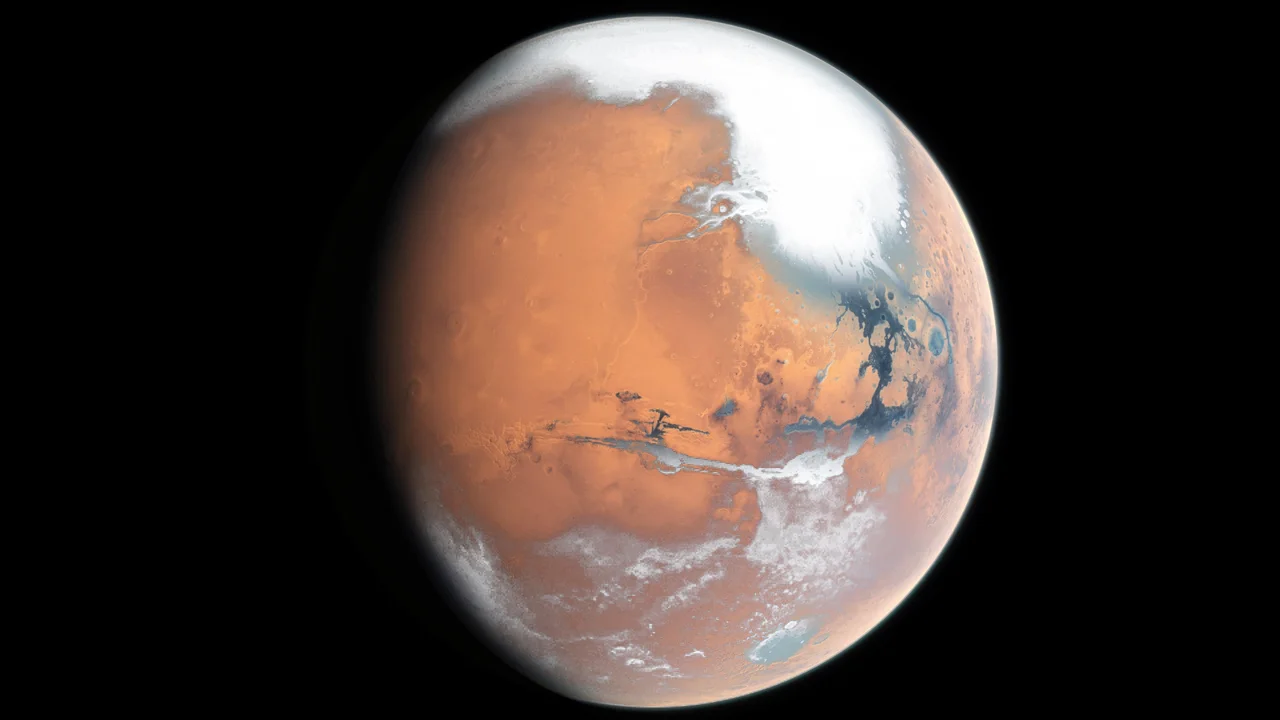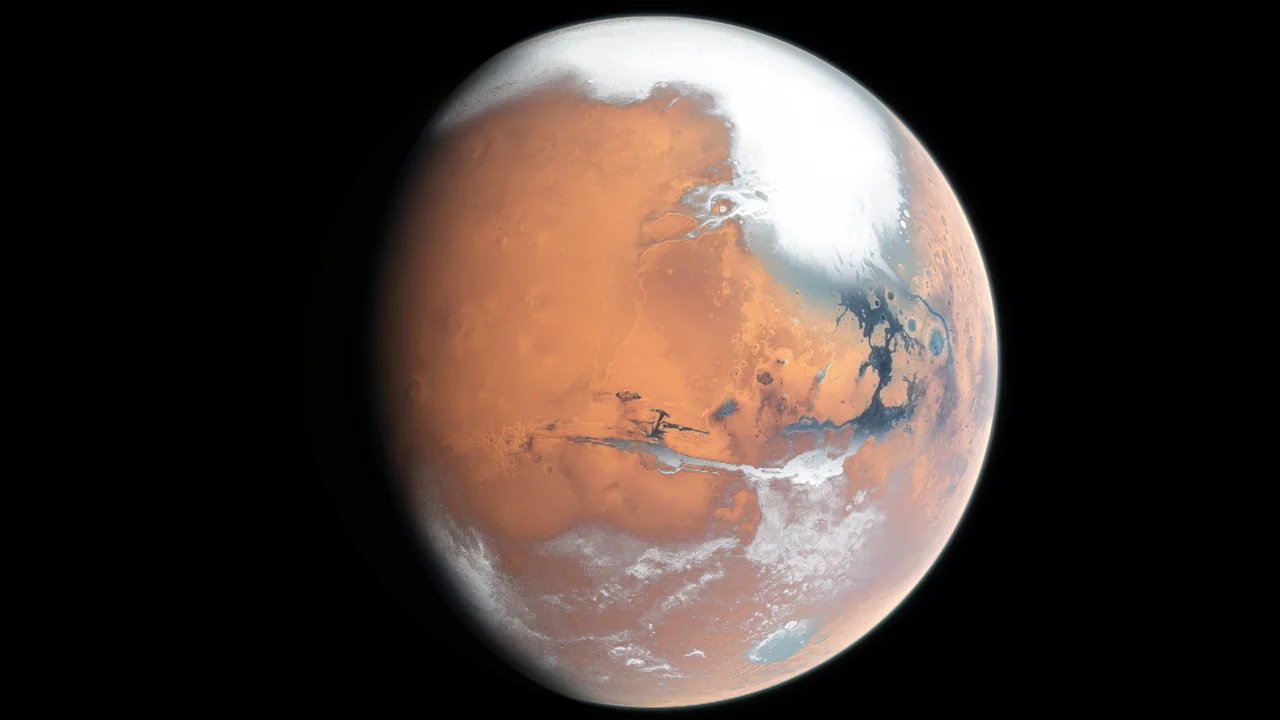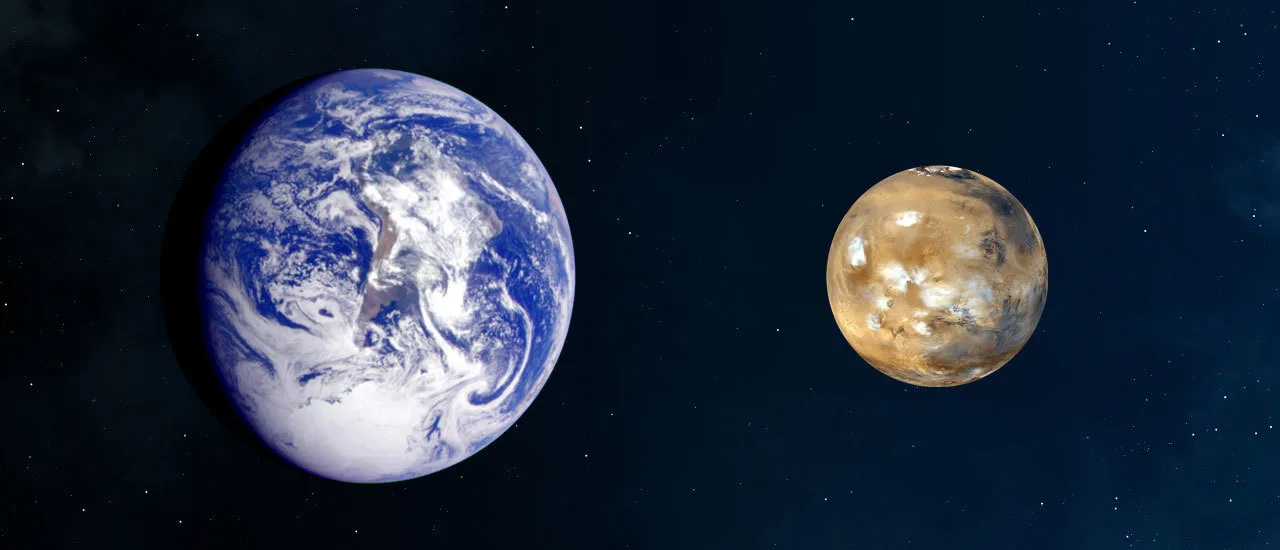
On 'Snowball Mars', immense glaciers may have sheltered ancient microbial life
An island in Canada's far north has helped scientists paint a very different picture of ancient Mars
What was Mars like billions of years ago? Was it truly a blue and green world, similar to Earth? Or was it something else? In a new study, Canadian researchers suggest the Red Planet may have been a Snowball Planet, with thick ice sheets covering the surface.
Over decades of Mars exploration, evidence sent back by robotic missions has presented a strong case that the planet was once a much warmer and wetter place, long ago. According to scientists, surface water on Mars would have even been suitable to drink, if we had been there at the time to sample it. It would undoubtedly have supported microbial life as we know it, as well. This has led to the idea that Mars was very Earth-like, with rainfall, and flowing rivers carving out the valleys and channels that scar its surface.

A simulated Mars with oceans. Credit: ESO/M. Kornmesser
A new study from researchers at the University of British Columbia and Western University is painting a different picture of ancient Mars, however.
Poring over high-resolution satellite images of Mars' surface, the research team identified many valleys that bore an uncanny resemblance to valleys on Devon Island in Canada's far north. The channels on Devon Island were not carved by rivers fed by rainfall, however. They were formed by water flowing under thick glacial ice sheets.
"For the last 40 years, since Mars' valleys were first discovered, the assumption was that rivers once flowed on Mars, eroding and originating all of these valleys," lead author Anna Grau Galofre, a former UBC Ph.D. student who is now at Arizona State University, told UBC News. "But there are hundreds of valleys on Mars, and they look very different from each other. If you look at Earth from a satellite, you see a lot of valleys: some of them made by rivers, some made by glaciers, some made by other processes, and each type has a distinctive shape. Mars is similar, in that valleys look very different from each other, suggesting that many processes were at play to carve them."

Two superimposed satellite images, one from Mars (greyscale, top) and one from Devon Island, in the Canadian Arctic (colour, bottom), reveal how the channel networks are nearly identical. Credit: Anna Grau Galofre/Arizona State University
"Devon Island is one of the best analogues we have for Mars here on Earth," Gordon Osinski, the director of Western University's Institute for Earth and Space Exploration and co-author on the study, told Western News.
Having led analogue missions on Devon Island for years now, Osinski is very familiar with the island's potential for teaching us about Mars' environment. Its barren conditions are excellent for simulating Mars of the present day, which is especially useful for testing out robotic rovers. It appears that the formations on Devon Island have a lot to say about Mars' past, as well.
"Our study challenges the widely held view that most valley networks on Mars were formed by rivers fed by precipitation," Osinski said. "While we found evidence consistent with a small handful of valley networks having formed in this way, our observations suggest that the majority formed beneath ice sheets."
WATCH BELOW: PERSEVERANCE - THE SEARCH FOR ANCIENT LIFE ON MARS
WARM-AND-WET OR SNOWBALL?
Mars' history is a complex one, and we do not yet know the entire story.
Today, it is a frigid, apparently barren world with an atmosphere thinner than we could experience even at the highest peaks on Earth.

The Curiosity rover's October 2019 selfie at Glen Etive highlights the barren nature of Mars. Credits: NASA/JPL-Caltech/MSSS
Billions of years ago, the planet may have been quite Earth-like, however. It likely had a planetary magnetic field, generated by its liquid metal core, which protected it against the solar wind and solar storms. It would have had a thicker atmosphere, allowing it to retain more heat from the Sun. This would have made it a warmer planet, capable of producing Earth-like weather systems. With clouds and rainfall, this would have created rivers of flowing water across the surface to carve the valleys and channels we still see there today.
One fact complicates this vision, however.
Nearly four billion years ago, when Mars could have had this more Earth-like environment, the young Sun was cooler than it is today. It's estimated that solar radiation was only around 70 per cent as intense back then. So, even with a thicker atmosphere, Mars would still have been quite frigid.
"Climate modelling predicts that Mars' ancient climate was much cooler during the time of valley network formation," Grau Galofre told UBC News.
Thus, the idea of a warm Mars, with an immense ocean and abundant free-flowing surface water, likely has to be put aside. Instead, a Snowball Mars may be the more likely case.

Based on M. Kornmesser's Mars with Oceans simulation, this simulated view shows extensive glaciers covering the planet's surface. Credit: ESO/M. Kornmesser/Scott Sutherland
"These results are the first evidence for extensive subglacial erosion driven by channelized meltwater drainage beneath an ancient ice sheet on Mars," co-author Mark Jellinek, a professor in UBC's Department of Earth, Ocean and Atmospheric Sciences, told UBC News.
LIFE ON MARS?
Mars' surface environment, today, is not a friendly one to biological life as we know it.
It got that way, from its likely more Earth-like conditions in the past, due to the planet's size. Being only about half the size of Earth, Mars' interior cooled down fairly quickly. When the churning of the liquid outer core slowed, it shut down the planet's magnetic field. This allowed the solar wind to slowly strip away the atmosphere, reducing its ability to retain heat, and exposing the surface to more intense ultraviolet radiation from the Sun.

Mars, 6,792 km wide at the equator, is just over half the size of Earth (equatorial diameter = 12,756 km). Credit: NASA
If the planet was warm and wet while this was happening, the water would have dried up or frozen solid as the atmosphere thinned. Meanwhile, any microbes and other simple lifeforms on the surface would have died due to the new harsher environmental conditions.
According to the research team, with thick glaciers covering much of the planet, the underlying surface would have been better protected from these changes. The dense ice would have prevented groundwater from evaporating into the thinning atmosphere. It would have also reflected and absorbed harmful solar radiation, blocking it from reaching anything living on the surface underneath.
Thus, a Snowball Mars may have provided a much better environment for microbial life, allowing it to survive for longer during the drastic changes in Mars' climate.
This increases our chances of discovering evidence of past life on Mars, which is one of the primary mission objectives of the new Perseverance rover NASA just launched to the Red Planet. It also increases the chances of discovering that life still exists on Mars, thriving deep under buried glaciers around the planet's surface.
Sources: UBC News | Western News | Nature Geoscience
